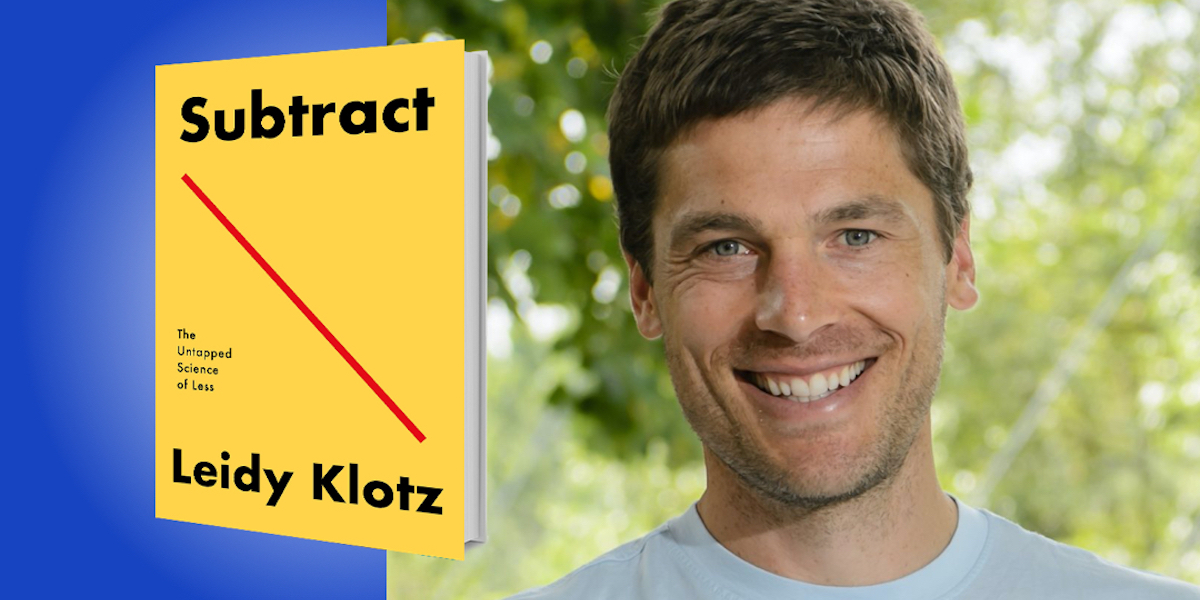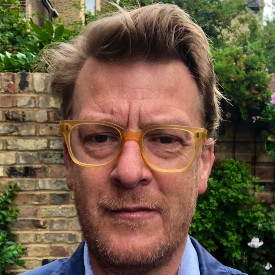Leidy Klotz is a Professor at the University of Virginia, where he teaches engineering, architecture, and business. His primary research interest is the science of design. He has written more than 80 articles and two books, and before starting his academic career, Leidy played professional soccer.
Below, Leidy shares 5 key insights from his new book, Subtract: The Untapped Science of Less (available now from Amazon). Listen to the audio version—read by Leidy himself—in the Next Big Idea App.
1. We systematically overlook subtraction.
A few years ago, my 3-year-old son and I were playing with Legos. We were trying to make a bridge, and the bridge wasn’t level because one of the columns supporting the bridge was shorter than the other column. I went to add a block to the shorter column, but before I could do so, my son had already removed a block from the longer column. He showed me in this moment that I had overlooked the idea of taking a block away to solve the problem of making a level bridge.
My research has shown that people systematically overlook subtraction. It happens not just in Legos, but in travel itineraries, recipes, and writing. When we’re trying to take things from how they are to how we want them to be, our first instinct is to think “What can I add?,” which means we’re overlooking one of the most basic ways to make change.
2. Our failure to subtract is a root cause; our cluttered calendars, closets, and inboxes are just symptoms.
A lot of contemporary authors urge us to subtract. Marie Kondo’s recommendation to get rid of everything that doesn’t spark joy has improved my life. Cal Newport has terrific advice about digital minimalism and getting rid of email. And Tim Ferriss’ The 4-Hour Workweek reminds us that one of the ways we can be more productive and get more joy out of our work is to do less of it.
“A poet knows he has achieved perfection not when there is nothing left to add, but when there is nothing left to take away.”
This kind of advice has been around for a long time, from thinkers like Lao Tzu (“To attain knowledge, add things every day. To attain wisdom, remove things every day.”) and Leonardo da Vinci (“A poet knows he has achieved perfection not when there is nothing left to add, but when there is nothing left to take away.”) But why do we need such advice? It’s because when left to our own devices, we tend to overlook subtraction as a way to solve problems.
3. We need to respect the forces that are pushing us toward more.
One of the reasons we tend to overlook subtraction as a solution for problems is that there are biological, cultural, and economic forces encouraging us to do more, not less. Just as male bowerbirds try to impress potential mates by building elaborate nests, humans have a tendency to display competence by making things.
When you build something, it sits there as firsthand evidence of your brilliance—whereas subtraction is rarely recognized, even when it’s a better solution to a problem. In San Francisco, the eastern waterfront was long covered by an unattractive double-decker freeway. When this was eventually removed, the spot became much more appealing. But the city planners who removed it had nothing visible to show for their brilliant decision. In fact, when I visited the waterfront, I had no idea that subtraction was to thank for this beautiful spot in the world.
Just as we can’t fly without respecting and understanding gravity, we can’t get to less without respecting the forces that are pulling us toward more.
4. We need to stop thinking “add or subtract” and start thinking, “add and subtract.”
One of the ways we reason is by positioning ideas relative to each other, such that if one idea is true, then some other idea cannot be true: If we add, then we cannot subtract; if we subtract, then we cannot add.
“To achieve wisdom for society and for us as individuals, we’ve got to get past this notion that bigger is better.”
When trying to solve a problem, our first instinct is usually to add, and since we imagine adding and subtracting are in opposition, we fail to consider subtraction. But if we can shift our thinking slightly from “add or subtract” to “add and subtract” new possibilities will occur to us.
One of my favorite examples is Maya Lin, who famously designed the Vietnam Veterans Memorial in Washington, D.C. One of the reasons that monument stands out is because of subtraction. Lin cut the monument into the earth, and made it much smaller and more understated than the other monuments on the Mall, and that makes it noticeable. But she also added—the monument includes the names of all the Americans who died in that conflict, which is not something seen on other nearby monuments. By adding and subtracting, Maya Lin created a design masterpiece.
5. Bigger is not necessarily better.
Just as we default to adding to our closets and calendars rather than subtracting, we also have a tendency to add to our mental models. And just as it’s harder to subtract in the physical world, it’s harder to subtract from our mental models, but it’s powerful when we do.
If you look at Nobel Prize winners and people who have made transformative scientific advances over the years, what they’ve often done is not necessarily added to our collective knowledge, but rather edited it. I think one of the reasons Adam Grant’s book Think Again has resonated so much is because it shows how the same editing of knowledge can work on an individual scale, how we can rethink some of the assumptions that are holding us back. To achieve wisdom for society and for us as individuals, we’ve got to get past this notion that bigger is better. Often, the more powerful approach to making change is by subtracting.
To listen to the audio version read by Leidy Klotz, download the Next Big Idea App today:































